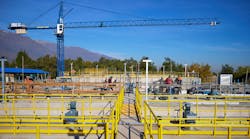The following is the first of 11 articles addressing ozone's applications, installation, sales, service, basics and more. The 12th and final installment will be a quiz to test your ozone knowledge—so make sure you come back each month to brush up. Details and instructions will be given in the final month.
Why Use Ozone?
What oxidizer can kill bacteria, impart no adverse taste or odor, be tested and verified that it is present and have no residual when consumed? Chlorine and hydrogen peroxide cannot work without filtration/destruction. Ultraviolet cannot. Ozone is the only choice left.
The main objective when using ozone for bottled water is to maintain ozone residual in the water as it is bottled. Ozone is required by public health agencies in many locations around the world.
The main purpose of ozonating bottled water is to improve the taste, increase shelf life, maintain a bacteria-free environment and comply with federal and local health regulations.
Ozone Dosage
Sizing the ozone equipment is based on several parameters.
* Maximum gpm of the water being bottled.
* Bottling water usage hours per day.
* Water quality to be ozonated.
* End users (bottler) objective for using ozone.
There are two ranges that are to be achieved. We call these ozone residual ranges. The ozone production from the ozonator is represented in grams per hour (gr/hr). The ozone residual in the water is measured as ppm-O3. (See "Ozone Residuals.")
Mid-Range is the most common. It will maintain ozone residual, a bacteria-free environment and will pass inspection. The high-range will kill bacteria that is present. Care must be taken with the high range because if misapplied, too much ozone could impart a burnt plastic taste and odor to the water.
Contact Time
Along with dosage comes contact time. There are no regulations as to the time required, but generally the mid-range does not necessarily need contact time. The high range will require additional contact time. This is accomplished with the use of a contact/off gas tank.
The Installation
The bottling ozone installation consists of an ozonator, ozone injector, air dryer, contact tank (optional) and an automatic actuation switch (optional).
Ozone typically is installed at the end of the line immediately before bottling or prior to the pressure tank after repressurization. Ozone saturation and mixing is immediate due to "Henry's Law" of physics. This method is far more efficient than injecting ozone into an atmospheric storage tank. Ozone will not escape or be wasted as with atmospheric tanks.
The ozonator is electrically connected to a control circuit that activates when bottling occurs or when an existing pressure switch is thrown.
The ozone injects, mixes and treats the water immediately when the circuit activates.
Ozonator Sizing
Once you know the gpm and the water quality you can select the ozonator.
(See "Ozonator Sizing Example.")
Ozone Injector Sizing
The ozone injector is the device used to get the ozone into the water. There are two methods-venturi and ozone pump.
Venturis are low-cost items, have no moving parts and require little or no maintenance. It is critical to size the venturi correctly according to the gpm and psi. Incorrect sizing will result in insufficient ozone injection. The venturi must be installed in specific locations or it will not create the proper suction. Pressure and water volume loss is typical.
Ozone pumps can accomplish injection in any location. They inject high concentrations of micro-bubbles (Henry's Law). They have moving parts and require periodic service.
The benefit is the ease of installation, sizing, higher volume of gas injected and no restriction of flow or pressure.
Air Dryer
Air dryers remove all of the humidity and moisture from the air prior to the ozonator. The air is dried to a minimum of -40° F dew point. Dry air greatly increases ozone production (two to three times) compared to atmospheric conditions.
Contact Tank
Extending contact time (CT) is accomplished by pressurized storage. CT is only important when bacteria are present. Once bottled, the ozone quickly dissipates due to the lack of pressure. The purpose of the contact tank is to maintain the ozone in contact with the water for a set/extended time prior to bottling. The tank design is basic with no moving parts or media. (Three to five minute CT is sufficient for bacteria elimination.)
Ozone Testing
Ozone residual must be verified in the bottles. Assuming you have adequate ozone going into the bottles can give you a false sense of security. Dissolved ozone gas is difficult to measure.
It requires sophisticated equipment, and a simple color comparator test kit is inadequate. The best test kit for this purpose is a hand-held electro-photometer. Testing will not become a standard practice until it becomes mandatory by the local health departments.
Pretreatment
Ozone systems can be used as the pretreatment to remove iron, sulfur, manganese, color, bacteria, taste and odor. This will keep polishing systems such as RO, softeners and carbon filters from fouling. Look for more information in future articles.
Download: Here

